
Sand dredging off the coast of Java has recovered more than 6,000 bones, including two fragments of skulls of the early humans Homo erectus. H. erectus and the other animals found there lived on territory long since swallowed by the sea. The finds refute the idea that early humans were isolated on Indonesian islands, showing they were often connected when low-lying areas were dry.
At the peak of recent ice ages, the islands of Indonesia and Australia were connected into three landmasses, with only a few deep channels separating them. We see the legacy of this in these islands’ animals and plants. Those that were once connected to mainland Asia through what is known as Sundaland share common species, very different from those that were connected to Australia instead.
The Madura Strait, between Java and Madura, was part of Sundaland several times during the coldest parts of the ice ages, so when dredging occurred there, the fossils it captured include the fauna of the era.
Java is central to what we know about H. erectus, arguably the most successful human species, having survived for 2 million years. All fossil species have a “type specimen” used for the initial scientific description, and in the case of H. erectus, this is known as Java Man. At one time, the entire species was referred to under that name, but we now know they were the first humans to inhabit most of Eurasia.
It was long thought, however, that H. erectus was isolated for most of its time on Java, unable to cross the straits to nearby islands. There’s been some pushback to that with recent studies raising the possibility that early humans’ sailing skills might have been underestimated.
However, two H. erectus skull fragments found in the Madura Strait dredging suggest the populations of what are now islands may have been able to interact without getting their feet wet.
The dredging was conducted in what would have been the valley of the Solo River when glaciers locked up much of the oceans, lowering their levels by around 100 meters (328 feet). River sand washed down from the Javan highlands turned bones in the deltas into fossils, and already, remnants of 36 species have been found in the dredged sand.
Some of the richest sources of H. erectus fossils in the world, including 11 partial skulls, come from the surviving parts of the Solo valley, including the youngest specimen from Java, around 112,000 years ago. The original Java Man skull fragment also comes from the area, but before the river had formed.
Such a location, where a river met the coast, would have been particularly attractive to the early humans. “Here they had water, shellfish, fish, edible plants, seeds and fruit all year round,” Leiden University PhD student Harry Berghuis said in a statement. “We already knew that Homo erectus collected river shells. Among our new finds are cut marks on the bones of water turtles and large numbers of broken bovid bones, which point to hunting and consumption of bone marrow.”
The skulls date from 140,000 years ago, the second last peak glaciation, a point in time where H. erectus was no longer the only human species in the region. Not only were there hobbits (Homo floresiensis) of Flores, but Denisovans, more closely related to modern humans, may have been in the area, possibly even interbreeding with the earlier arrivers.
The number of bovine bones, and the marks on them, indicate they were hunted by H. erectus, not just scavenged when weak. “We didn’t find this in the earlier Homo erectus population on Java, but do know it from more modern human species of the Asian mainland. Homo erectus may have copied this practice from these populations,” Berghuis said. “This suggests there may have been contact between these hominin groups, or even genetic exchange.”
Sundaland, at the time, would have most closely resembled the current African savannah, with many similar species inhabiting it.
The treasure-trove of fossils found in the dredging is now on display at the Geological Museum in Bandung, Indonesia, marking an insight into early human lifestyle that can’t be seen anywhere else.
The study is open access in Quaternary Environments and Humans.
Source Link: 140,000-Year-Old Homo Erectus Remains Discovered Alongside Other Animals In Drowned Sundaland